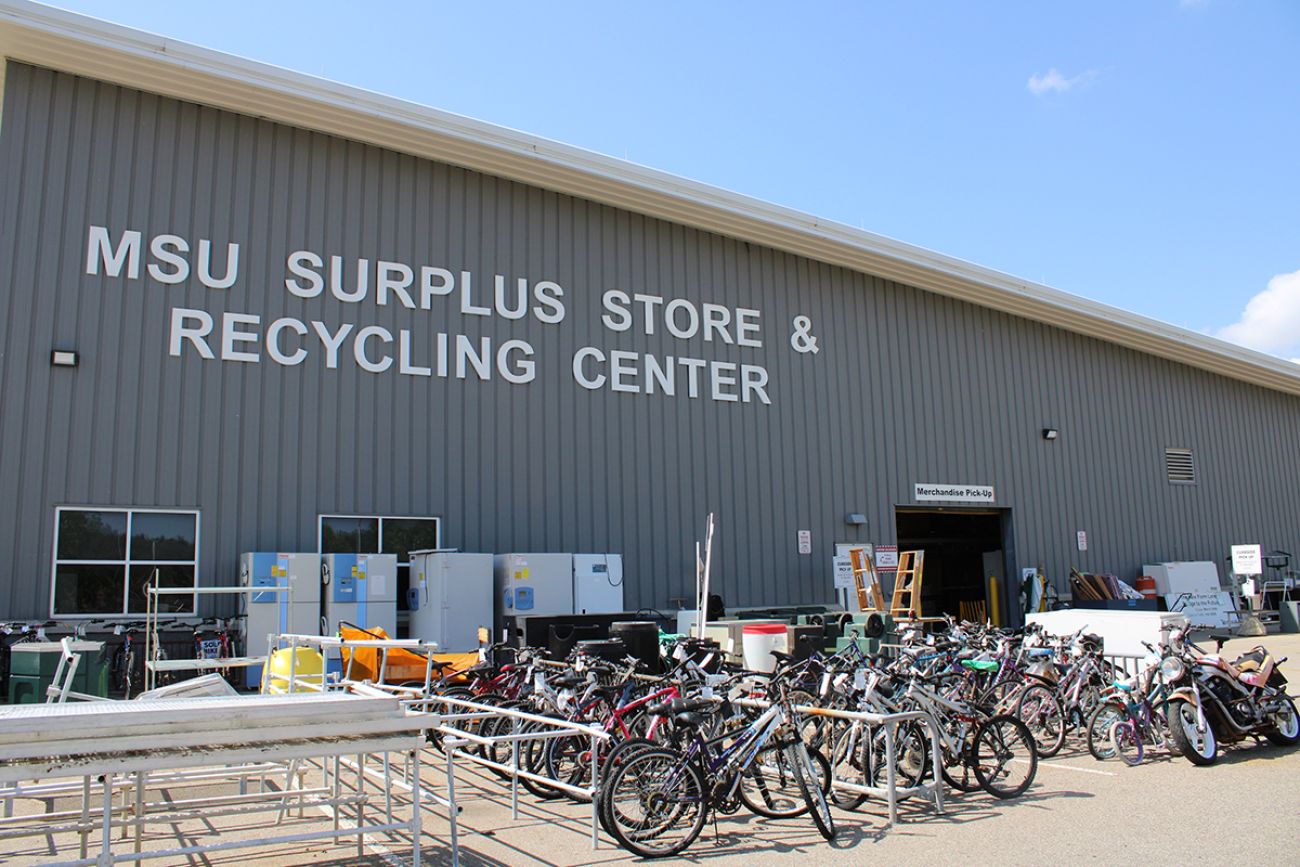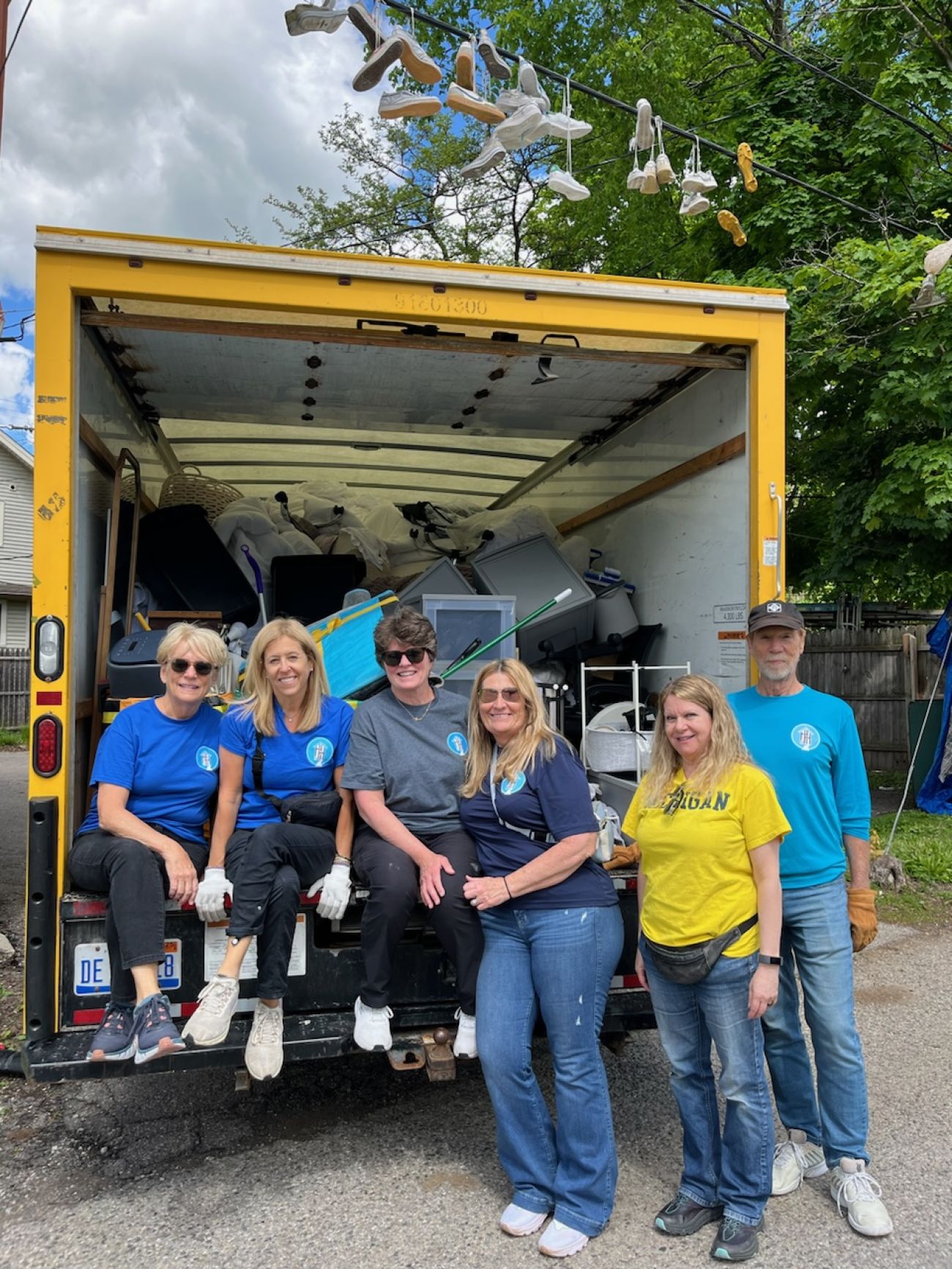Trash into treasure: Rethinking waste in Michigan college towns

- Students throw away piles of unwanted but usable items each spring during college move-out
- But organizations are keeping some of those items out of the landfill by reselling them or using them to furnish apartments for homeless people
- More still needs to be done to reduce landfill waste in Michigan
The last week of April was Chris Hewitt’s “Super Bowl.” It was move-out week for Michigan State University’s dorms, and 16,000 Spartans were heading out of East Lansing — and leaving behind trash, recyclables and discarded furniture.
By the end of the week, the operations manager of the Michigan State University Surplus Store and Recycling Center and his crew had “picked up 500,000 pounds of material from the residence halls,” he said.
And that was just from students living in on-campus housing.

Michigan college towns produce mountains of waste each spring as students move out of dorms and apartments and leave dumpsters and curbsides piled high with unwanted, but often perfectly usable, appliances, furniture and other items.
Now, some of those items are finding new homes thanks to college town organizations with a mission to reuse trash to benefit the community, including one program in Ann Arbor that is using discarded student furniture to furnish apartments for homeless people.
Related:
- Michigan recycling rate ticks up, but still short of state goal
- Michigan is No. 1 for trash, but Whitmer wants higher fees to curb imports
- Detroit recycling rates double, but barriers remain
Donating or selling old student desks, beds and mini-fridges makes only a small dent in Michigan's refuse, acknowledged leaders of efforts in East Lansing and Ann Arbor, but Hewitt said he looks forward to finding new ways to divert waste from landfills.
“We always try to remember that in the long run, we’re doing good for the university,” he said. “We have made improvements and we will continue to do so.”
The ‘disposable life’ and waste diversion
As Bridge has previously reported, Michigan produces more landfill garbage per resident than anywhere else in the country.
Michigan disposed of 8.2 million tons of trash in 2022, and state data indicate that 84% of that trash is recyclable or compostable.
The blame falls in part on Michigan’s low landfill “tipping” fees, which make it cheaper to throw trash away rather than find a new use for it.
So we keep sending trash to landfills, which smells, takes up space and releases greenhouse gasses as the trash slowly decomposes, said Samantha Pickering, the public and environmental health policy coordinator at the Michigan Environmental Council.
“We’ve been moving into this disposable life since the ‘50s or ‘60s,” said Pickering. “But since the COVID pandemic, getting things delivered, not going out and shopping as much, just packaging-wise, there’s been so much more [trash].”
Pickering said waste diversion programs are easier to implement on smaller scales since waste management happens at the city level.
Efforts on the campuses of MSU and the University of Michigan are examples of how that can work.
In Ann Arbor, House N2 Home takes donated items from college move-out each spring to furnish homes for people exiting homelessness.
“I live in Ann Arbor and my daughter went to the university, so I saw the waste at the end of the year,” said Heidi Ruud, who volunteers at House N2 Home.

So Ruud hopped on Facebook Marketplace, asking students to donate their furniture if they couldn’t find a buyer. And nine times out of 10, Ruud said, they donated.
Now, House N2 Home partners with U-M Office of Campus Sustainability, the City of Ann Arbor and several sororities and high-rise student apartment buildings to keep usable furniture and appliances out of the dumpsters each spring.
Jesse Krugel, a graduating U-M film student, and his housemates donated three mattresses, three bed frames, two couches, two desks, a bookshelf and a few other kitchen appliances to House N2 Home this spring. Ruud had to return to the house twice to fit everything in the organization’s van.
Krugel, who’s moving to Los Angeles, said House N2 Home was the easiest, most affordable option for moving-out since Ruud came and picked up his unwanted furniture at no cost.
“I’m on a pretty tight timetable, and I like to procrastinate things. So honestly, maybe I would’ve sold a couple things on Facebook Marketplace or just paid a junk-removal place to come take it,” said Krugel. “But I don’t have a lot of time to coordinate all of that. I just need to get rid of it.”
Ruud said many students she took items from shared Krugel’s view.
“I think students and parents are looking for a way to give [their unwanted items] to someone. It’s just there’s no one to take it,” said Ruud. “So we’re trying to fill the gap.”
Krugel said he thinks other students would give to House N2 Home if they knew about the opportunity.
“If someone asked me, ‘How do I move out with all this furniture?’ I would definitely recommend [House N2 Home],” he said. “It feels good, too, because you’re giving to a good cause instead of just throwing it out and adding to the landfill.”
Krugel and his roommates’ furniture will likely help furnish an apartment for someone who needs it.
Last year, House N2 Home furnished 352 homes for 740 people in Washtenaw County. And while not all the furniture and appliances come from college students, all of it has been diverted from landfills.
Ruud said volunteering for House N2 Home is the most rewarding thing she’s ever done in her life, especially because many of the homes they furnish are for single mothers and their children.
“They leave us their keys with an empty apartment, leave for like two hours, and when they come home, it’s 100% furnished,” she said. “They see their girl’s pink bed and princess lights. It’s something they could never provide for their children, but now they don’t have to worry about it.”
Going beyond reuse
At MSU, this spring’s move-out produced 44 tons of reusable items, according to the Surplus Store data.
The Surplus Store sells the items to other students and community residents like a university-scale thrift store.
In addition to the 44 tons from move-out, items like computers and lab equipment from classrooms, microwaves and water filters from student housing — even the odd particle accelerator part — are collected from campus and brought to the Surplus Store.
Operations Manager Chris Hewiit said the Surplus Store’s mission is to find creative ways to keep as much waste from campus out of the landfill as possible. Whatever they can’t resell is sorted for recycling or composted right at the same facility.
Over the last 12 months, the Surplus Store diverted 44% of discarded campus material from the landfill, including 5.6 million pounds that were recycled, 2.25 million pounds composted and 2.25 million pounds sent to the Surplus Store for reuse.
Its recycling operations have reduced the amount of waste sent to the landfill per student by 66% since 1990.
Operations Manager Hewitt said universities should provide convenient options for students to donate.
For MSU and U-M, that means having donation boxes in the lobby of every residence hall and setting up donation tents near apartment-style housing.
“It’s all one giant operation to reduce the university’s landfill and also its environmental footprint,” Hewitt said.
The success of small, city-based initiatives like House N2 Home and the MSU Surplus Store should encourage other cities to start their own initiatives, said Ruud.
“There’s so much more need out there,” she said.
Michigan Environment Watch
Michigan Environment Watch examines how public policy, industry, and other factors interact with the state’s trove of natural resources.
- See full coverage
- Subscribe
- Share tips and questions with Bridge environment reporter Kelly House
Michigan Environment Watch is made possible by generous financial support from:
Our generous Environment Watch underwriters encourage Bridge Michigan readers to also support civic journalism by becoming Bridge members. Please consider joining today.
See what new members are saying about why they donated to Bridge Michigan:
- “In order for this information to be accurate and unbiased it must be underwritten by its readers, not by special interests.” - Larry S.
- “Not many other media sources report on the topics Bridge does.” - Susan B.
- “Your journalism is outstanding and rare these days.” - Mark S.
If you want to ensure the future of nonpartisan, nonprofit Michigan journalism, please become a member today. You, too, will be asked why you donated and maybe we'll feature your quote next time!






